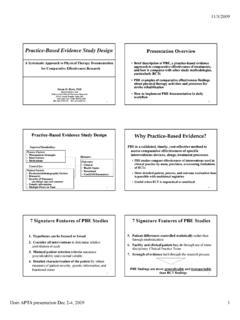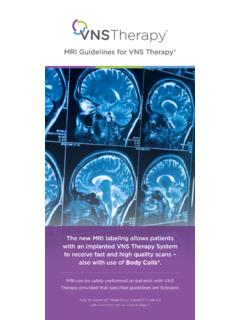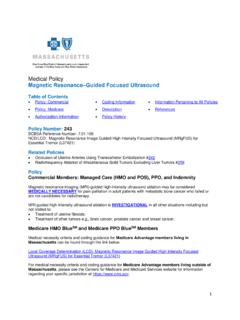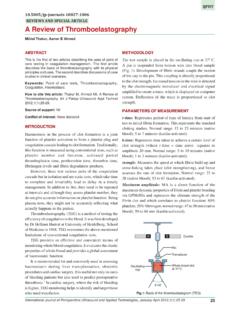Transcription of Effectiveness of Ultrasound Therapy in …
1 International Journal of Scientific and Research Publications, Volume 3, Issue 2, February 2013 1 ISSN 2250-3153 Effectiveness of Ultrasound Therapy in Combination with Manual Therapy and Shoulder Exercises for Sub Acromial Impingement Syndrome Praveena Thiruvasagar Department of Physiotherapy of Faculty of Allied Health Sciences UNIVERSITY OF PERADENIYA SRI LANKA Email: I. INTRODUCTION Background The shoulder joint has the greatest range of motion of any joint in the body. Because of this mobility the shoulder is more likely to be injured or cause problems. They include sprains, strains, dislocations, separations, tendinitis, bursitis, torn rotator cuffs, frozen shoulder, fractures and arthritis. Among these conditions sub acromial impingement syndrome is the most disabling condition of the shoulder. (Hermoso, , 2009).
2 Sub acromial impingement syndrome (SIS) is a painful impingement of the supraspinatus tendon and sub acromial bursa between the head of the humerus and coracoacromial arch, which is a frequent cause of shoulder pain (Aktas I et al 2007). It is characterized by severe pain in the anteroposterior and lateral shoulder extending to the deltoid and biceps area. It is caused by overuse or repetitive micro trauma sustained in the overhead position (Williamson MP et al 1994). It is currently believed that stiffness and thickening of the coracoacromial ligament (Hypvonen, P 2003), lesions to the long head of the biceps, sub acromial bursitis and partial or full thickness tears of the rotator cuff (Calis HT et al 2011) and abnormal scapular kinematics(Hebert LG et al 2002) are the different aetiologies for SIS Figure 1 Sub acromial Impingement Syndrome Physiotherapy is often the first choice of treatment for SIS.
3 Between 10 to 30% of all shoulder patients seen in primary care are referred to physiotherapy after initial presentation, Physiotherapy is widely used in the management of SIS which includes various treatment methods such as shoulder exercises, manual Therapy , and electrotherapy. Physiotherapy has been found to be effective in reducing pain and disability in patients with shoulder impingement (Michener, et al 2004). International Journal of Scientific and Research Publications, Volume 3, Issue 2, February 2013 2 ISSN 2250-3153 Ultrasound is a commonly used electrotherapeutic modality for impingement as well as other forms of tendinitis and muscle injury. Therapeutic Ultrasound is a modality commonly used by physiotherapist. Ultrasound Therapy works by driving alternating compression and rarefaction of sound waves with a frequency of more than 20,000 cycles per seconds.
4 Therapeutic Ultrasound may have two types of benefits, namely thermal effects and non-thermal effects. Thermal effects aid in pain relief whereas non-thermal effects enhance cell-repair effects of the inflammatory response ( , et al 2004). Reduction in pain and induce tissue repair helps in regaining the reduce range of motion due to SIS. Figure 2 Therapeutic Ultrasound apparatus When recovering from a shoulder injury physiotherapy exercises are an integral part in regaining the range of motion, muscle elasticity, and strength. Therapeutic exercises can be defined as the use of active or assisted exercises aimed at improving the range of motion, strength or dynamic neuromuscular control of joint motion, whereas manual Therapy can be defined as the use of manually and/or mechanically applied movement techniques to improve joint motion ( ).
5 Both therapeutic exercises and manual Therapy are commonly used as part of physiotherapy programs aimed at improving shoulder kinematics. Therapeutic exercise focusing on strengthening the rotator cuff and scapula stabilizing musculature has been shown to be effective in treating shoulder impingement symptoms (Bang MD et al 2000) Manual or manipulative Therapy encompasses the treatment of health ailments of various etiologies through hands-on , physical intervention. Various manual Therapy techniques have proved to be effective for SIS. Stretching reduces capsular tightness (D Hespeel , 2004) and a few studies have evaluated the Effectiveness of incorporating glenohumeral joint mobilizations for SIS (Bang MD et al 2000). Figure 3 Manual Therapy and shoulder exercises International Journal of Scientific and Research Publications, Volume 3, Issue 2, February 2013 3 ISSN 2250-3153 Problem Justification The shoulder is the most movable joint in the body.
6 However, it is an unstable joint because of the range of motion allowed. This instability increases the likelihood of joint injury. The most common cause of shoulder pain in the older population is soft tissue injuries. These include frozen shoulder, sub acromial impingement, rotator cuff tendinopathy or rupture, arthritic conditions, degeneration and, or destruction of the joint and referred pain from cervical radiculopathy. (Hermoso, , 2009) Shoulder instability and acromioclavicular joint disorders tend to affect younger people, particularly men who play certain sports that involve repetitive shoulder movements, such as overarm bowling or throwing and contact sports, such as rugby. Among the different diagnoses covered by the concept of shoulder pain, the most common is sub acromial impingement syndrome which is increasingly more common in athletes whose sports involve repetitive overhead motions as well as in the older population.
7 This condition is used in our study as majority of sub acromial impingement may be successfully managed with conservative treatment. (Arcuni SE2000). Specific supervised exercises obtain improvements in the range of movement and muscular function by restoring the shoulder's mobility and stability. Physiotherapeutic options include several electrotherapy techniques. Among them Ultrasound (US) Therapy is more popular. Although adequate literature provides evidence to prove the Effectiveness of various therapeutic exercises and manual Therapy techniques (Lori A. et al 2004), the Effectiveness of US Therapy in the treatment of SIS is still under debate. According to some studies Ultrasound Therapy added to conservative treatment of SIS do not provide an additional benefit to the patients, (Celik D et al 2009, Valma, J et al 2001) and some other studies also reveal that the Effectiveness of US in the treatment of SIS is limited.
8 (Santamato A et al 2009). In spite of the limited evidence to prove the Effectiveness of US in the treatment of SIS it is a widely used electrotherapeutic modality to treat patients with soft tissue injuries including SIS. Based on this our study was designed to assess whether US Therapy helps in rehabilitation of SIS in the acute and sub-acute stages. The patients were referred only from Kurunegala and Peradeniya teaching hospitals due to the limited accessibility. Occurrence of SIS does not differ according to the age and sex of the patients and it was equally distributed in the age group from 18-55. The age of selected patients was ranged from 18 to 55 according to the limited availability of the patients with pure impingement and the equal distribution of this condition in this range. Objectives General objectives To assess the Effectiveness of Ultrasound Therapy when added to manual Therapy and shoulder exercises in the rehabilitation of patients with sub acromial impingement syndrome.
9 Specific objectives To assess the Effectiveness of the Ultrasound with manual Therapy and shoulder exercises. To assess the Effectiveness of manual Therapy and shoulder exercises in treating sub acromial impingement syndrome Hypothesis Null hypothesis (H0) Ultrasound Therapy is not beneficial when combined with manual Therapy and exercises in the physiotherapy management of patients with SIS to reduce pain, increase range of motion and to reduce shoulder disability International Journal of Scientific and Research Publications, Volume 3, Issue 2, February 2013 4 ISSN 2250-3153 Alternative hypothesis (H1) Ultrasound Therapy is beneficial when combined with manual Therapy and exercises in the physiotherapy management of patients with SIS to reduce pain, increase range of motion and to reduce shoulder disability. II. REVIEW OF LITERATURE What is subacromial impingement?
10 Brotzman (2003) reported that impingement is a chronic inflammatory process produced as the Rotator Cuff muscles (Supraspinatus, Infraspinatus, Teres minor and Subscapularis) and the Subdeltoid bursa pinched against the coracoacromial ligament and the anterior acromian when the arm is raised above 80 degrees. The supraspinatus, infraspinatus portion of the rotator cuff is the most common area of the impingement. This syndrome is commonly seen in throwing sports, in racquet sports, and in swimmers, but can be present in anyone who uses the arm repetitively in a position over 90 degrees of elevation. (Brotzman SB et al 2003) Sub acromial impingement syndrome most frequent reason of the painful shoulder syndrome. Painful shoulder syndrome is a frequent cause of visit to a physician. The development of knowledge about the anatomy and biomechanics of the shoulder allows, based on detailed examination, to precise localization of the shoulder dysfunction.

















